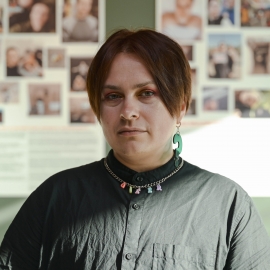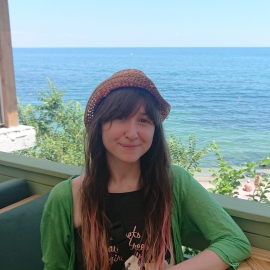Transgender people in Ukraine, like everyone else, risk every day being killed by Russian weapons. Unlike cisgender citizens, they face additional challenges, such as specific medical needs; transphobia in society, the media, and among loved ones; complications related to military service; etc. Trans people who were forced to become temporary migrants in other countries face a striking difference between the trans transition system in Ukraine and abroad, transphobia and misunderstanding in shelters, and lack of resources for survival. Yet they fight, volunteer, work, engage in art, go to rallies and marches in other countries, and continue helping Ukraine in any way they can.
Like in any other group, among trans people there are also those who do not want to invest in winning. However, since this group is traditionally marginalized in any society, that is, alienated, transgender people often receive much more criticism for the actions of its specific representatives than happens in other cases. Non-binary and gender non-conforming people generally go unnoticed; on the one hand, this is good as they are thus less subjected to general hatred, but on the other hand, restrictions on their rights and opportunities are even higher than those of trans men and trans women.
The Ukrainian trans community, of course, primarily seeks victory over Russia. In addition to the common desire of all Ukrainians to stop the rabid colonizer neighbor, trans people have a doubly negative attitude towards Russia. “The Russian World” uses transgenderism as one of the major factors of fear. The president of Russia often intimidated Russians with the image of transgender people (“transformers” in his words) to turn them against Ukraine and the so-called “collective West.”
In July 2023, Russia passed a law completely banning any medical procedures for trans transition, for transgender people to adopt, change the gender marker in documents, etc. Similar laws have been passed in some U.S. states and in some African and Asian countries, and digging a little clearly reveals the Russian traces in that. Attempts to submit anti-LGBTQI+ and anti-trans draft laws were also made in Ukraine (Zavhorodnia’s article on politics 2023), but, fortunately, none of them made it to a vote.
A Brief Chronology of Trans Issue in Independent Ukraine
The first document regulating transgender transition in Ukraine was Order #57 in 1996. It allowed taking any transgender transition steps only from the age of 25 and provided for mandatory sterilization, a stay in a psychiatric clinic, and a medical board review. Without genital surgery and a humiliating public analysis by a group of doctors, it was impossible to get permission to change the gender marker in documents. The situation was complicated by the fact that there was only one commission in the country and people had to spend additional money on a trip to the capital to pass it.
In 2011, the new Order #60 entered into force. In fact, it involved few changes. Transgender people also had to spend 30-45 days in a psychiatric hospital to receive a preliminary diagnosis, which was then confirmed or denied by a medical board. Based on commission results, a person gained the opportunity to perform surgical operations. A denial could be challenged in court.
Usually, the commission considered vaginoplasty for transwomen and mastectomy and hysterectomy for transmen to be a sufficient number of operations. After the operations, the person went before the commission again and only then received permission to change their documents. In addition, there were a number of contraindications, in particular “sexual disorders,” which included homosexuality.
Only in 2016, thanks to the active work of trans activists and the support of the Minister of Health Ulyana Suprun, a new trans transition protocol was approved based on orders #972 and #1041. This protocol mandated some medical intervention (usually hormone replacement therapy) and a psychiatric diagnosis, but a stay in the hospital is not required, and any family doctor can issue a certificate to a trans person to change their documents — there is no longer a single commission. Besides, now, with certain restrictions, transgender transition is also available for teenagers from the age of 14.
Yes, the protocol is still far from perfect and there is still much work to do, in particular regarding recognizing non-binary people and implementing the 11th edition of the International Classification of Diseases (ICD). However, Ukraine abandoned forced sterilization earlier than some EU countries, and thanks to the inclusion of family doctors in the transition protocol, trans people can receive the necessary treatment quite quickly, without queues and months or years of waiting.
Social Needs and Problems Facing Transgender People in 2022-2023
During Russia’s full-scale invasion, the main issues facing transgender people have become very acute. In February-March 2022, trans people forced to leave Ukraine often faced discrimination and misunderstanding by the border services. Some border guards had never seen people whose appearance differs from the photo in their documents and does not correspond to the gender marker specified. Transwomen who did not have time to change their documents could be recorded as men fleeing mobilization, while many people heard for the first time of the existence of transmen. Victims of discrimination turned to LGBTQI+ organizations.
The organization Gender Stream carried out a great deal of related work. Its activists advised border guards, helped people pass border control who had the legal grounds for doing so, and supported transwomen who had not yet changed their documents but were in the process and in communications with military enlistment commissions.
Unfortunately, there were also cases of illegal border crossing by transwomen. The singer Zi Famelu illegally left for Germany and gave numerous media interviews about the terrible transphobia in Ukraine. She did not ask for help from any of the Ukrainian organizations that could solve her problems regarding documents, while her stories for the Western press involve numerous inaccuracies and exaggerations. Of course, transphobia does exist in Ukraine, but not at such a staggering scale as Zi describes.
In total, non-governmental organization (NGO) Nash Svit (“Our World”) recorded 77 hate crimes based on sexual orientation and gender identity in 2022, of which six cases were described as transphobic. Mostly, this included violence by parents against transgender teenagers or young people, and cases of sexual violence against transgender women, physical attacks, and transphobic insults were also recorded. These were only the cases that victims reported to the organization’s monitors.
Often, victims of transphobic violence do not know that crimes must be recorded or are so used to transphobia and abuse that they do not consider what happened to them to be a crime. In 2023, one of the largest cases was an attack on transgender soldier Helen Mark in Lviv on August 15. Ombudsman Dmytro Lubinets and LGBTQI+ organizations KyivPride and Gender Stream joined the case.
At the same time, transgender journalist and military volunteer Sarah Ashton-Cirillo was appointed as the English-speaking spokesperson for the Territorial Defense Forces of the Ukrainian Armed Forces. This caused a huge wave of transphobic reactions on social media, in particular from Right Sector activists and less-known far-right groups. However, this appointment demonstrates that Ukraine, albeit slowly, is moving towards the supremacy of human rights and non-discrimination.
In addition to right-wing radicals and some radical feminists always react to the visibility of transgender people. “Gender-critical” or trans-exclusive radical feminists (TERFs) hold the same transphobic views as conservatives and, sometimes, consciously or unconsciously support their views. For example, Maria Dmitrieva, leader of the largest radfem Facebook community Feminism UA (14,000 members), supported the content of military blogger Yevhen Karas, who is known for not only his homophobic and transphobic statements, but also his hatred of feminists, sexism, and organizing massive online attacks on female activists.
In Ukrainian TERF circles, the concept of “trans docs” is popular, which is how participants call activism for transgender people’s rights, informing about transgenderism, or news related to it. Fortunately, they do not have as much influence on the country’s political situation and public opinion as, for example, in the USA, UK, and European countries. Most often, their activities do not go beyond social media, especially during the full-scale invasion.
On the officially conservative side, several new players have appeared over the past year and a half. In addition to Karas, who is also a regular contributor to Censor.Net and Vsi Razom (“All Together”), transphobic rhetoric was promoted by the Freikorps volunteer unit on its YouTube channel, blogger Neautorka, Catharsis channel, the Association of Sexologists and Sex Therapists of Ukraine (did you expect to see a name like that on this list?), Aleksey Arestovich, Iryna Fedyshyn, and others. Some posts addressed the entire LGBTQI+ community, but many focused specifically on transgender people.
Interestingly, all these resources mainly responded to news from abroad, for instance, many posts touched on American trans people and the U.S. laws that limit their rights. Also, Ukrainian conservatives were outraged by advertising campaigns involving transgender people in other countries, European prides and beauty contests, transgender characters in Western media, etc. During the full-scale invasion, Ukrainian LGBTQI+ organizations are engaged in humanitarian work, do not organize public events, and have become less visible; hence, conservative movements pay less attention to them.
Meanwhile, attacks on activists mainly take place online. Demonized images of Edward Rees, Marharyta Kovalova, Michelle Karas, and others appear in the campaign materials of Ukrainian anti-trans movement figures. The main accusations look like the renewed rhetoric of American conservatives: transgender people are pedophiles who want to seduce and convert children into transgenderism and take away women’s rights. There are unique Ukrainian narratives as well: merging the LGBTQI+ movement with communism and claims that trans people work for Russia and seek the defeat of the Ukrainian army. The statements, of course, lack evidence. However, as I have already mentioned, when stories about transgender military personnel appear in the media, conservative bloggers start actively looking for ways to denigrate them and devalue their service.
Trans* Ukrainians and the Army: How Trans* Status Affects the Issue of Conscription. Transgender Soldiers
The number of transgender and non-binary personnel in the Armed Forces of Ukraine, as well as the number of LGBTQI+ military personnel in general, is unknown. Stories have recently appeared in the media of non-binary mortar person Antonina Romanova, transwoman Oksana Surchok serving in an assault unit, non-binary military member Kafa from the 93rd Mechanized Brigade Kholodnyi Yar, and others. Being openly trans in the military is hard for many reasons, and potential transphobia from colleagues is far from the most important ones. During service, it is not easy to continue hormone replacement therapy (HRT) and military personnel often take a forced break from treatment, which can have a very negative effect on physical and mental health. In addition, a transgender person may face problems when enlisting.
In February 2023, Human Rights Center Nash Svit published the report “The Battle for Freedom. LGBTQ Situation in Ukraine in 2022,” which, among other things, mentioned the diagnosis F64.0 “Transsexualism” as a condition that exempts a person from military service. With “severe” gender dysphoria, a person is considered completely unfit. On the other hand, this diagnosis can mean unfitness in peacetime and limited fitness in wartime if these conditions are “moderately expressed with unstable compensation or compensated.”
The “severity of expression” and “compensation” of these conditions should be determined by a special medical commission, for instance, at a regional psychiatric hospital. The next step is confirmation of the conclusion by a military enlistment commission. In practice, few hospitals have staff capable of conducting such an examination, and even more so, one should not expect expertise from the military enlistment commission. Before the start of the full-scale invasion, psychiatric departments in Kyiv and Odesa, which had a lot of experience working with transgender people, did not specify the severity of transgender expression in their medical reports.
This report, published by numerous media outlets, caused a negative reaction, primarily from radical opponents. After all, the material was presented as if all transgender people were eager to leave the country and were using their diagnosis for this, whereas transwomen, transmen, and non-binary people fight and often face misunderstanding and discrimination during voluntary mobilization if their appearance does not match the gender marker in their passport.
According to Nash Svit, there are trans people who fight while concealing their transgender status. They have already received documents with their preferred gender marker, are stealth (do not tell anyone that they have transitioned), and serve as a cisgender male or female. I am also aware of the story of a transgender man who volunteered for the army at the start of the war, and none of his comrades knew that he was a transgender person.
Medical Needs and Issues of Transgender People
Problems with medications are not limited to the military. Transgender people who stayed in Ukraine faced a shortage of hormonal drugs, especially at the beginning of the full-scale invasion. Most of the drugs disappeared from pharmacies as they are not produced in Ukraine and imports were limited. Currently, the situation has somewhat improved thanks to the established supply and support of international organizations such as Convictus and ILGA or Ukrainian LGBTQI+ organizations and initiatives bringing hormones to Ukraine on their own. This is a huge and complicated job since transgender diagnoses are not included in any state protection programs like care for HIV patients or people with disabilities. In addition, the Ukrainian transit protocol does not specify the names of drugs that should be prescribed to patients; hence, it is almost impossible to organize mass supplies of medicines to Ukraine at the international level.
Many transgender people had to postpone officially transitioning and changing documents for several years because psychiatric hospitals did not accept patients during the COVID-19 lockdowns. This also led to the issues described previously, such as transgender women already being on HRT for some time still had male documents and could not evacuate. Another complication was added during the full-scale invasion: many friendly family doctors, psychiatrists, and endocrinologists who were both documenting the transition and consultations on HRT and preparing for operations left to go abroad - of course, not all of them, but many. Besides, already in 2022-2023, public organizations were conducting training in trans*specific medical work, but there is a lack of specialists. The cost of healthcare and medicines has significantly increased compared to 2021, making life very difficult for transgender people who lost their homes and jobs due to the war.
Implementing ICD-11: Current Status
In the 11th edition of the International Classification of Diseases, the diagnosis “Gender Dysphoria” or “Gender Nonconformity” was removed from the psychiatric disorders section and moved to the sexual health section. In essence, this is the depathologization of transgenderism, which can later lead to the adoption of laws on self-identification, that is, greatly simplifying the process of trans transition. Many countries in Europe and the world have begun working according to ICD-11 principles even before its introduction and gave transgender people the opportunity to change their gender marker in documents without a psychiatric examination. In Ukraine, ICD-11 implementation was supposed to start in 2022. It officially entered into force on January 1, 2022, but it does not work in practice yet. The Ukrainian medical system is to adapt to the new ICD by 2027.
According to trans activist Inna Iryskina, “implementation of the 11th edition of the International Classification of Diseases does not require the mandatory update of clinical protocols to its diagnostic codes. These are two separate processes.” Iryskina, who works with the NGO Insight on processes to implement ICD-11, insists on developing a new protocol, although this is not mentioned in official documents.
“Hypothetically, a situation is possible when the diagnosis of trans people will take place according to the 2016 protocol with a psychiatric examination and ICD-10 codes (with the same F64.0 ‘Transsexualism’), while in statistical reporting it will go under ICD-11 codes (‘Gender Nonconformity’).”
Currently, according to Inna, the first draft of translating ICD-11 into Ukrainian is ready. In the future, various experts are planned to be involved in its finalization. Also, with experts’ participation, perspectives will be discussed and specific implementation plans developed. The Insight team joined these processes, which, however, will definitely not be fast, in particular because of the war. Still, the activist considers implementing ICD-11 as inevitable in Ukraine for Ukraine’s accession to the EU and NATO.
Transgender Ukrainians Abroad
Transgender people who left Ukraine after the start of the full-scale invasion face specific challenges that are different from the lives of trans people in Ukraine and from the situation facing cisgender refugees. Many of them return to Ukraine because they cannot overcome these problems. Even if people have lost their homes in Ukraine due to the war, they seek refuge in LGBTQI+ shelters in Kyiv and other cities as they do not find opportunities to comfortably exist abroad.
In European countries, there is no centralized program to help LGBTQI+ refugees from Ukraine. Sometimes, they can get support from local organizations, such as a place in a friendly shelter or in an apartment with local LGBTQI+ people, but usually transgender people live with other refugees in shelters and hostels. In these conditions, they often encounter transphobia and violence, which is difficult to avoid since there may be no other place and local authorities are not always sensitive to transgenderism.
Trans people under 18 or those forced to leave with their relatives for other reasons often have to live in the transphobic environment of their loved ones with no choice or possibility to escape. Refugee families share rooms or small apartments, and if parents have previously resorted to violence, the risk of abuse increases in such conditions. In the KyivPride community, I have observed several stories like this. Before the full-scale invasion, teenagers managed to enroll in universities and leave their abusive parents for another city, starting a transgender transition there. But in 2022, already having visible signs of hormonal changes, they again found themselves in the same room with their relatives.
According to a Gender Stream study published in August 2023, there is a lack of understanding of intersectionality principles in the placement and care of Ukrainian refugees in Europe. In refugee camps, Ukrainians face transphobia both from their own people and from representatives of other nationalities forced to seek refuge.
In addition, the European medical system significantly differs from the Ukrainian one, in particular with regard to transgender health. Local doctors do not always accept Ukrainian F64.0 certificates, and patients cannot get drugs for hormone therapy. For example, I had to stop hormone therapy three months after starting it when I ended up in Denmark as a temporary migrant. The Danish medical system is unfriendly to trans people, although the principle of self-identification for changing documents has long been officially introduced there. Still, in order to get therapy, both HRT and surgery, you need to wait for several months to several years: first, for an appointment with a psychotherapist, then for permission for surgical intervention and a place in a clinic. At the first appointment, a trans person can simply be denied continued treatment for gender dysphoria if they are considered “not transgender enough” or if they have mental disorders. This situation is true for other countries as well, in particular ones where right-wing parties and trans-exclusive radical feminists have influence in the parliament and government. The impossibility of continuing trans transition is often the reason why transgender people return to Ukraine, as well.
Will Transgender People Come Back to Ukraine after Victory?
As I said in the previous section, many transgender people have already come back home. Others come to Ukraine from time to time to, for example, visit their endocrinologists, get or buy hormonal drugs, or complete the process of changing documents. There are also people who do not plan to return under any circumstances because they have found more acceptable conditions for themselves abroad. For instance, trans women who crossed the border illegally at the start of the full-scale invasion will have no way to return, even if they wanted to. These trans people’s stories end with an application for asylum in host countries involving the prospect of later obtaining full citizenship.
Conclusions and Consulting
What is needed for more people to return and have the desire to live in Ukraine after victory?
First, ICD-11 must still be fully integrated into our health care system. This will not only facilitate the transition process, but also help transgender people with accompanying problems to improve their quality of life. In the new classification of diseases, the attitude to mental health has also been modernized.
Second, draft law #5488 should be adopted, which introduces the concepts of “hate speech” and “crimes based on intolerance” into Ukrainian legislation and is one of the conditions for Ukraine’s accession to the European Union. Transgender people around the world are one of the groups most vulnerable to such crimes, and Ukraine is no exception. If cases of transphobic attacks are investigated properly, aggression will decrease and transgender people will feel safer.
Third, we need more friendly doctors who know how and are willing to work with transgender people. Unlike many European countries, where transgender health is cared for only in specialized gender clinics, any specialists can do that in Ukraine. But to do so, they need to receive special additional education, in particular, learning the principles of non-discrimination of transgender and non-binary people. This training is occasionally conducted by LGBTQI+ organizations, but there is no specialization at the state level. This is especially felt when it comes to psychiatric and surgical treatment. Therefore, I see the major direction of work with the Ministry of Health here: inclusion of trans issues in medical university programs and creating full-fledged professional development courses for doctors in cooperation with experts from trans organizations.
Literature:
Звіт про злочини на ґрунті ненависти за ознаками СОҐІ в Україні 2022 року (для щорічного звіту БДІПЛ / ОБСЄ). Правозахисний центр «Наш світ». 23 квітня 2023 року.
Дослідження[A1] становища ЛГБТІК+ біженців і біженок за кордоном. Gender Stream. 24 березня 2023 року. Research of the Situation of LGBTQI+ Refugees Abroad. Gender Stream. March 24, 2023.
Битва[A2] за волю. Становище ЛГБТК в Україні 2022 року. Правозахисний центр «Наш світ». 9 лютого 2023 року. The Battle for Freedom. LGBTQ Situation in Ukraine in 2022. Nash Svit Center. February 12, 2023.



















